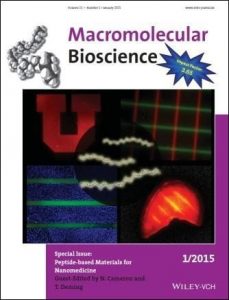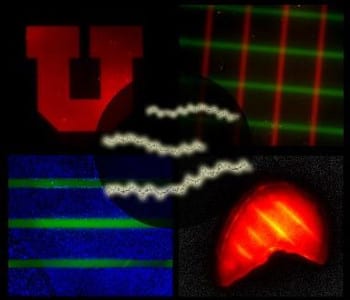 There have been many recent breakthroughs in the creation of designed peptide and polypeptide sequences to make candidate materials for applications in medicine as scaffolds (artificial tissues, implants), therapeutic carriers (micelles, vesicles, emulsions) and for analysis (biosensors, medical diagnostics). This year’s first issue in Macromolecular Bioscience – available to access for free throughout 2015 – is a special issue entitled “Peptide-based Materials for Nanomedicine” guest-edited by Neil Cameron and Timothy Deming and highlights exciting developments in the application of peptide and polypeptide based materials in medicine.
There have been many recent breakthroughs in the creation of designed peptide and polypeptide sequences to make candidate materials for applications in medicine as scaffolds (artificial tissues, implants), therapeutic carriers (micelles, vesicles, emulsions) and for analysis (biosensors, medical diagnostics). This year’s first issue in Macromolecular Bioscience – available to access for free throughout 2015 – is a special issue entitled “Peptide-based Materials for Nanomedicine” guest-edited by Neil Cameron and Timothy Deming and highlights exciting developments in the application of peptide and polypeptide based materials in medicine.
The issue contains both in-depth reviews of contemporary topics as well as papers describing the latest developments in the field. Smits and van Hest review the preparation of nanoparticles obtained from stimuli-responsive elastin-like peptides and peptide hybrids, while Danial and Klok provide an overview of polymeric anti-HIV therapeutics.
Several of the primary research articles showcase the preparation of diverse polypeptides by ring-opening polymerization of N-carboxyanhydrides (NCAs). Barz and coworkers demonstrate the preparation core-shell structures based on polypept(o)ides using a mannopyranoside as initiator in NCA polymerisation. Micelle-forming PEO-peptide hybrids that encapsulate doxorubicin are described by Lecommandoux et al. In this work, the NCA-derived polypeptide is clicked to PEO-azide to generate hybrid block copolymers.
Deming and coworkers show how blending together diblock copolypeptides leads to the production of cell penetrating polymersomes, while Cameron et al. describe the production of polypeptide nanoparticles from diblock copolypeptides, and their loading with the ocular drug dexamethasone. Heise et al. have prepared glycosylated star polypeptides by NCA ring-opening polymerization then functionalization of the polypeptide side chain with sugars.
Other papers describe work that employs solid phase synthesis methods to prepare sequence-defined peptides. Kiick, Theato and coworkers present the preparation of hybrid materials involving collagen-like peptide sequences coupled to thermoresponsive polymers. Caged collagen-mimetic peptides that, upon exposure to UV, pattern gelatin films and hydrogels to encourage spatially-defined cell attachment are described by Yu et al. while Boerner and coworkers present their work on polymer-peptide hybrids as solubilisers for poorly water-soluble drugs. Finally, Cornellissen and coworkers demonstrate how virus-like particles (VLPs) can be prepared from plant viruses, thus harnessing Nature’s ability to produce exquisitely defined peptides. The VLPs are clustered by different polymers leading to well-defined and ordered arrays of nanoparticles, which have intriguing possibilities in nanomedicine.
The broad and diverse range of topics presented in this themed issue highlights the state of the art in the area of peptide-based materials for nanomedicine and demonstrates the health of this young field. We hope you enjoy reading the articles.

















